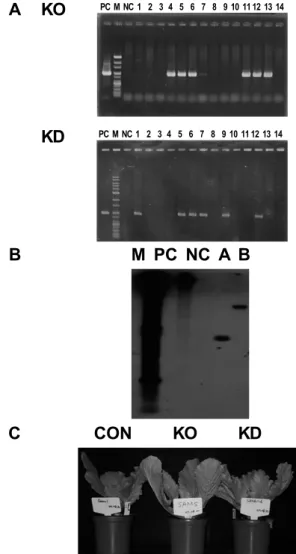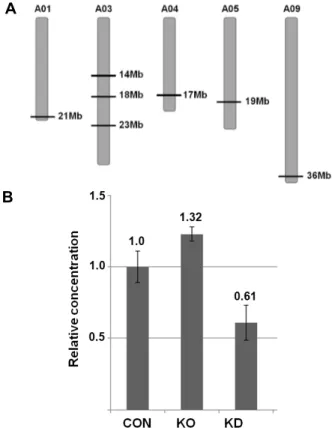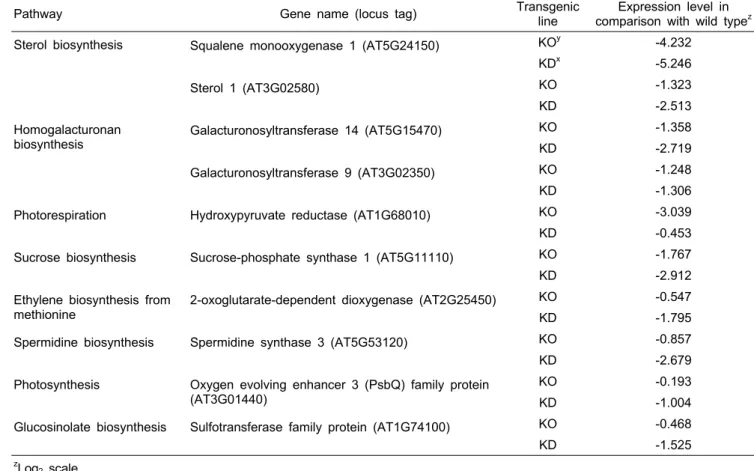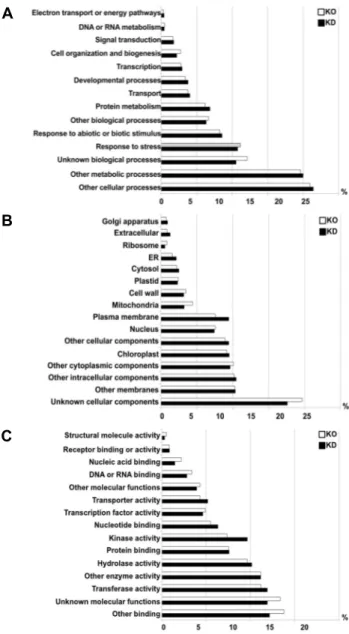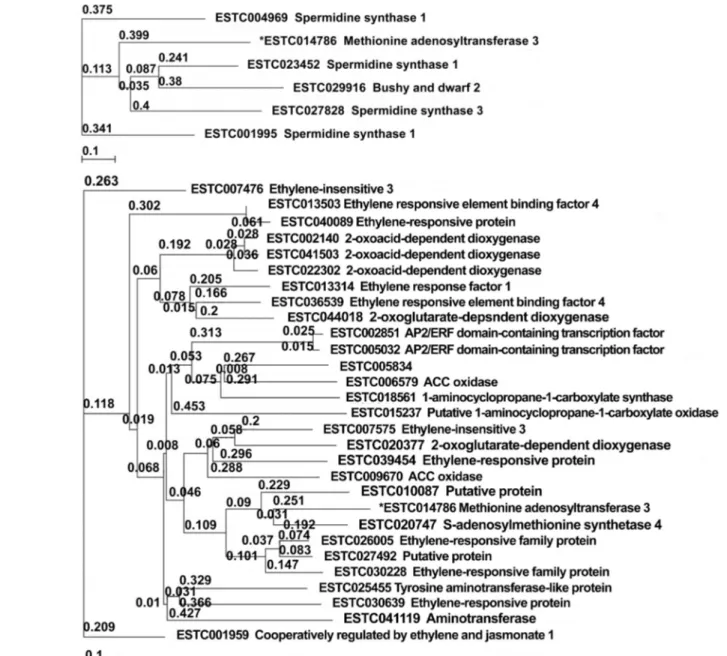Kor. J. Hort. Sci. Technol. 30(6):734-742, 2012 DOI http://dx.doi.org/10.7235/hort.2012.12093
RNA Interference 및 T-DNA Integration 방법에 의한 배추 기능유전자 Silencing 효과 비교
유재경ㆍ이기호ㆍ박영두* 경희대학교 생명과학대학 원예생명공학과
Comparison of RNA Interference-mediated Gene Silencing and T-DNA Integration Techniques for Gene Function Analysis in Chinese Cabbage
Jae-Gyeong Yu, Gi-Ho Lee, and Young-Doo Park
*Department of Horticultural Biotechnology, Kyung Hee University, Yongin 446-701, Korea
Abstract. To compare RNA interference-mediated gene silencing technique and T-DNA integration for gene function analysis in Chinese cabbage, BrSAMS-knockout (KO) line and BrSAMS-knockdown (KD) line were used. The KO line had lost the function of a Brassica rapa S-adenosylmethionine synthetase (BrSAMS) gene by T-DNA insertion and the KD line had shown down-regulated BrSAMS genes’ expression by dsRNA cleavage.
From microarray results of the KO and KD lines, genes linked to SAMS such as sterol, sucrose, homogalacturonan biosynthesis and glutaredoxin-related protein, serine/threonine protein kinase, and gibberellin-responsive protein showed distinct differences in their expression levels. Even though one BrSAMS gene in the KO line was broken by T-DNA insertion, gene expression pattern of that line did not show remarkable differences compared to wild type control. However, the KD line obtained by RNAi technique showed prominent difference in its gene expression. Besides, change of polyamine and ethylene synthesis genes directly associated with BrSAMS was displayed much more in the KD line. In the microarray analysis of the KO line, BrSAMS function could not be clearly defined because of BrSAMS redundancy due to the genome triplication events in Brassicaceae.
In conclusion, we supposed that gene knock-down method by RNAi silencing is more effective than knock-out method by T-DNA insertion for gene function analysis of polyploidy crops such as Chinese cabbage.
Additional key words: knock-down, knock-out, microarray, S-adenosylmethionine synthetase
*Corresponding author: ydpark@khu.ac.kr
※ Received 9 May 2012; Revised 29 June 2012; Accepted 18 July 2012. 본 연구는 2011년도 경희대학교 학술연구교수 지원사업에 의한 결과임(KHU-20110210).
서 언
T-DNA 삽입 또는 gene silencing 기법을 이용한 돌연변 이체 유기는 유전자 기능을 밝히는 데 있어 매우 유용한 방 법이다(Baulcombe, 2004; Page and Grossniklaus, 2002;
Travella et al., 2006). 식물에서 Agrobacterium tumefaciens 의 T-DNA를 이용한 삽입돌연변이체 유발은 돌연변이체의 표현형을 나타내는 유전자의 분석을 위한 연구 방법이다 (Krysan et al., 1999). 그러나 이러한 접근 방법은 생명유지 필수 유전자의 knock-out으로 인한 세포/식물체 사멸과 멀 티유전자(multiple genes) 및 배수성(polyploidy)에 의한 유
전적 여유로 인해 제약이 따른다(Travella et al., 2006). 한 편, RNA interference(RNAi) 방법은 목표 유전자에 상동성 을 보이는 double-stranded RNA(dsRNA)를 세포 안으로 도 입하게 되는데 , 이 dsRNA가 목표 유전자 RNA의 발현을 저하시킨다. 아울러, dsRNA는 목표 유전자와 기능이 유사 한 집단 안에서 자신과 동일한 염기서열을 가지는 거의 모 든 유전자의 발현을 저하시킬 수 있다. 이렇게 발생된 목표 유전자의 발현억제로 그 유전자의 기능을 알 수 있게 된다 (Baulcombe, 2004; Elbashir et al., 2001; Lawrence and Pikaard, 2003; Miki et al., 2005).
S-adenosylmethionine synthetase(SAMS)에 의해 합성되
는 S-adenosylmethionine(SAM)은 S-adenosyl-L-methione, AdoMet, SAMe, SAM-e 등의 이름으로 다양한 생물학적・
세포적 대사과정에 중요한 역할을 하는 것으로 알려져 있다.
SAM은 핵산(DNA, RNA), 단백질, 지방, 다당류, 이차대사 산물의 transmethylation 반응에 메틸기(-CH
3)를 제공해 준 다(Chiang et al., 1996; Espartero et al., 1994; Lim et al., 2002; Sánchez-Aguayo et al., 2004). 예를 들어, 애기장대에 서 물관, 체관, 후막조직의 목질화 현상은 SAM을 이용한 리그닌의 합성에 의해 발생된다(Peleman et al., 1989). SAM 은 SAM decarboxylase에 의해 decarboxylated SAM으로 변환되는데, 이 decarboxylated SAM은 폴리아민(spermidine, spermine)의 합성에 propylamine group을 제공하는 역할을 한다(Tassoni et al., 2008). 또한 식물체에서 SAM은 다양한 생리학적 대사과정과 스트레스 반응에 관여하는 호르몬인 에틸렌의 합성 전구체로 작용하기도 한다(Sánchez-Aguayo et al., 2004; Tabor and Tabor, 1984; Yang and Hoffman, 1984).
본 연구는 T-DNA 삽입에 의해 SAMS 유전자가 knock -out된 형질전환계통(KO)과 SAMS의 일부분에 상보적인 dsRNA를 이용한 RNAi 기법에 의해 SAMS family 유전자 들의 발현을 knock-down한 형질전환계통(KD)을 이용하여, 배추와 같은 배수체(polyploids)에서의 유전자 기능분석에 있어 T-DNA insertion 기법과 RNAi 기법을 비교하고자 수 행하였다.
재료 및 방법
배추 형질전환 계통 육성
본 실험은 서울배추(Brassica rapa subsp. pekinensis cultivar Seoul)를 형질전환에 이용하여, T-DNA의 삽입으로 Brassica rapa S-adenosylmethionine synthetase(BrSAMS) 유전자가 knock-out된 BrSAMS-knockout(KO) 계통과 RNAi 기법을 활용해 BrSAMS 유전자가 knock-down된 BrSAMS- knockdown(KD) 계통을 확보하였다. KO 계통은 hygromycin 저항성 유전자와 T-DNA 삽입 위치를 확인하기 위한 ampi- cillin 저항성 유전자를 가지는 T-DNA tagging용 pRCV2 vector를 이용하여 생산하였다(Lee et al., 2004). 한편 KD 계통은 post-transcriptional gene silencing(PTGS)을 통한 내 생 SAMS 유전자의 발현을 억제하기 위해 SAMS 내 520bp 의 단편을 sense와 antisense 방향으로 삽입시킨 RNAi용 pJJSAMS vector를 이용하여 생산하였다(Kim et al., 2012).
Agrobacterium을 이용한 배추 형질전환 방법은 Lee et al.
(2004)의 방법을 이용하였다. 이렇게 확보된 T
1세대의 두
계통은 25 ± 1℃, 70% 습도, 24시간 중 16시간 동안 200μE
・m
-2・s
-1의 광을 조사하는 생장상에서 재배되었다. 본엽이 5-6매 정도 발생했을 때 잎을 채취하였고 phenol과 chloroform 을 이용하여 gDNA를 추출하였다(Yu et al., 2010).
Polymerase Chain Reaction(PCR) 분석
KO 계통과 KD 계통의 형질전환 여부를 확인하기 위해 서 HPT(hygromycin phosphotransferase)1 primer(5'-AGCC TGACCTATTGCATCTCC-3')와 HPT2 primer(5'-GGTTG TTACAGGACTGCCTGT-3')를 사용하여 PCR 검정을 실 시하였다. PCR 반응은 genomic DNA 1μL(100ng), HPT1 과 HPT2 primer(10pmol) 각각 1μL, 2.5mM dNTPs 2μL, Taq polymerase(5units・μL
-1) 0.5μL, 10× buffer 2μL, 그리고 나머지는 멸균수를 첨가하여 최종 반응액이 20μL가 되도록 하였다. PCR 조건은 94℃에서 5분간/1회 predenaturation 한 후 94℃에서 30초간 denaturation, 58℃에서 30초간 annealing, 72℃에서 1분간 extension 과정을 40회 반복하 고, 마지막으로 72℃에서 5분간/1회 final extension 하였다.
증폭된 PCR산물은 1× TBE buffer를 사용하여 1% agarose gel 상에서 100V, 30분간 전기영동하여 ethidium bromide (EtBr)로 염색한 후, UV illuminator를 이용하여 반응산물을 확인하였다.
Southern Hybridization 분석
PCR로 확인된 형질전환체의 genomic DNA 30μg을 제 한효소 HindIII를 첨가하여 37℃에서 18시간 동안 반응시 킨 후 0.5× TAE buffer를 사용하여 1% agarose gel 상에 서 30V, 15시간 전기영동하였다. 이 gel을 0.25N HCl로 depurination 시킨 후 제한 효소가 처리된 gDNA를 0.4N NaOH로 18시간 처리하여 Hybond-N+ nylon membrane(GE Healthcare, Buckinghamshire, UK)으로 옮겼다. [
32P]-dCTP 로 labeling된 960bp(hygromycin)의 probe로 18시간 동안 혼성화(0.5M NaHPO4, 1mM EDTA, 1% BSA, 7% SDS, 65℃) 반응된 nylon membrane을 2× SSC, 0.1% SDS와 0.1× SSC, 0.1% SDS로 각각 65℃에서 15분간 세척하였다.
그 후 nylon membrane을 -80℃에서 48시간 동안 X-ray 필 름에 노출시켜 삽입된 T-DNA의 수를 확인하였다.
RNA 추출
본 연구에 사용된 RNA는 두 계통의 배추 형질전환체와
대조군의 잎에서 추출하였다. 본엽이 6-7매 되었을 때, 잎을
채취하여 액체질소에 얼려 막자사발을 이용하여 분쇄하였
다. 분쇄된 잎의 분말은 RNA extraction buffer와 acidic
A KO
PC M NC 1 2 3 4 5 6 7 8 9 10 11 12 13 14PC M NC 1 2 3 4 5 6 7 8 9 10 11 12 13 14
KD
B M PC NC A B
C CON KO KD
Fig. 1. PCR and Southern hybridization analyses for T-DNA insertion and phenotype characterization from knock-out and knock-down lines. (A) PCR analysis of transgenic Chinese cabbage plants with pRCV2 and pJJSAMS vector. KO,
BrSAMS-knockout line; KD, BrSAMS-knockdown line; PC,hygromycin resistance gene; M, 1Kb size marker; NC, wild type; lane 1-14, transgenic plant of T
1-progeny. (B) Southern hybridization. M, λ HindIII size marker; PC, pRCV2 plasmid DNA; NC, wild type; A, knock-out line; B, knock-down line.
(C) Phenotypic characterization of the KO and KD lines.
CON, wild type; KO, BrSAMS-knockout line; KD, BrSAMS- knockdown line.
phenol로 처리한 후 원심분리하였다. 원심분리 후 분리된 수 용성 액체에 600μL의 phenol/chloroform을 첨가하고 다시 2차 원심분리한 후, 8M LiCl을 처리하여 -20℃에서 1시간 동안 반응시켰다. 그 후 ammonium acetate와 ethanol로 추 출된 RNA pellet은 DEPC가 처리된 RNase-free water를 이 용하여 녹였다.
Microarray 분석
Microarray 분석은 Brassica rapa 300k microarray ver.
2.0(Nimblegen, Madison, WI, http://www.nimblegen.com) 을 이용하여 수행하였다. cDNA 칩의 혼성화실험은 Yu et al.(2012)에 제시된 방법과 동일하게 수행하였다. 먼저 13μg DNA를 19.5μL의 2× hybridization buffer(Nimblegen, Madison, WI)와 혼합한 뒤 증류수를 첨가하여 최종 부피 를 39μL로 하였다. 혼성화실험은 42℃에서 16시간 동안 MAUI chamber(BioMicro, Salt Lake City, UT)를 이용하 여 진행하였다. 그 후, 칩을 solution I, II 및 III(Nimblegen, Madison, WI)를 이용하여 세척한 후 건조시켰다. 완성된 칩 은 Genepix 4000 B(Axon Instruments)로 시그널을 확인하 였으며, Nimblescan(Nimblegen, Madison, WI)을 통해 수치 화하였다.
Chip Data 분석
칩의 시그널 세기는 Loess Normalization 방법에 의해 정 규화(nomalization)하였고(Yang et al., 2002), log
2값으로 변환하였다. 5% 이하의 유의성을 가지는 probability(p) 값과 false discovery rate(FDR)값의 주요 유전자들은 해당 기능 분석을 위해 Arabidopsis database(http://www.arabidopsis.
org)를 이용하였다. 이 중 신뢰도가 더 높은 FDR 값을 이용해 분류된 주요 유전자들은 TAIR(http://www.arabidopsis.org) 의 gene ontology annotation을 이용하여 3가지 기능 범주 (biological process, cellular component, and molecular func- tion)로 나뉘어 분석하였다. 또한 이들은 multi-experiment viewer(MeV) program 내 hierarchical clustering 분석법을 이용하여 대조군(CON) 대비 형질전환체 유전자들의 발현 패턴을 시각화하였다.
결과 및 고찰
배추 돌연변이체 확보 및 유전자 발현 양상 분석
SAMS 유전자가 knock-out된 계통(BrSAMS-knockout, KO 계통)과 knock-down된 계통(BrSAMS-knockdown, KD계통) 을 생산하기 위해 각각 pRCV2 vector와 pJJSAMS vector로
형질전환하였고, 본 연구에 이용된 두 계통의 T
1세대들은 각각의 vector에 의해 도입된 T-DNA 내부의 hygromycin 저항성 유전자의 PCR과 염기서열 분석을 통해 선발하였다 (Fig. 1A). 선발된 형질전환체들은 hygromycin 저항성 유전 자를 이용하여 Southern hybridization 분석을 한 결과 한 개 의 T-DNA가 삽입되어 있음을 확인할 수 있었다(Fig. 1B).
그리고 두 계통의 생장을 비교해 본 결과, KO 계통은 대조
계통과 비슷한 성장속도를 보인 반면 , KD 계통의 경우는
초기에는 생장속도가 비슷했으나 성숙모본으로 생장해 갈
수록 대조 계통보다 느린 생장속도를 보였다(Fig. 1C).
Table 1. Genes showing over 2-fold expression level in the BrSAMS-knockout (KO) and BrSAMS-knockdown (KD) compared with a non-transgenic (CON) lines (p value < 0.05).
Sample set No. of up-regulated genes No. of down-regulated genes No. of total genes
KO/CON 1,073 (425)
z858 (263) 1,931 (688)
KD/CON 1,649 (715) 1,195 (428) 2,844 (1,143)
z
FDR < 0.05, the false discovery rate (FDR) values were calculated by 100 simulations.
A
B
Fig. 2. Predictive sites of SAMS in B. rapa genome (A) and
BrSAMS expression level of the KO and KD lines comparedwith wild type using quantitative real-time PCR (B). CON, non-transgenic line; KO, BrSAcMS-knockout line; KD, BrSAMS -knockdown line.
SAMS의 mRNA 발현 수준은 quantitative real-time PCR 로 확인하였으며, 내부 대조 유전자인 actin 유전자의 일정 한 발현을 통해 실험의 신뢰성을 확인하였다. Quantitative real-time PCR의 결과, KO 계통의 경우 SAMS 유전자가 knock-out되어 배추 내 SAMS의 발현이 대조 계통보다 낮을 것으로 예상하였으나 실제로는 낮아지지 않았다(Fig. 2). 그 이유는 비록 plasmid rescue 분석에 의해 pRCV2 vector의 T-DNA가 SAMS의 exon 부분에 삽입되어 그 기능을 상실한 것으로 확인되었으나, 다른 SAMS family 유전자들이 발현 하여 상실된 기능을 어느 정도 보상한 것으로 보인다. 실제 로 배추의 10개 염색체 중 1, 4, 5, 9번 염색체에 각각 1개씩 그리고 3번 염색체에는 3개의 SAMS 유전자가 존재하는 것 으로 확인되었다(Multinational Brassica Genome Project, http://www.brassica.info) (Fig. 2A). 한편 dsRNA를 형성하
여 SAMS mRNA의 발현을 억제시킨 KD계통의 SAMS 발현 수준은 대조 계통에 비해 약 2배 정도 감소한 것으로 나타났 다 (Fig. 2B). 이는 dicer에 의해 생성된 small interfering RNAs (siRNAs)로 인해 7개의 BrSAMS 중 다수의 유전자들의 발 현이 저하된 결과로 보인다. 이 결과를 바탕으로 선발된 두 계통의 형질전환체들은 본 연구의 최종목표를 수행하기 위 한 microarray 분석의 재료로 사용되었으며, 계속 세대진전 을 하였다.
KO 계통과 KD 계통에서의 유전자 유사 발현 양상 분석
KO 계통과 KD 계통의 microarray 분석에서 대조 계통
(CON) 대비 특이한 발현을 보인 유전자들을 그 발현 수준
을 log
2값으로 변환한 후, p value와 FDR value를 적용하여
선발하였다 (Table 1). 이렇게 선발된 주요 유전자들은 MeV
program을 통해 대조 계통과 비교하여 발현 수준에 따라 2
개의 cluster로 구분하였으며, KO 계통과 KD 계통의 cluster
내 유전자들 중, 특히 sterol, homogalacturonan, glucosinolate,
spermidine, 자당(sucrose)의 생합성 관련 유전자 및 광합성 관
련 유전자의 발현 패턴은 매우 유사하였다(Fig. 3). Table 2
에서 보는 바와 같이 sterol 생합성 관련 유전자(AT5G24150
와 AT3G02580)의 발현 감소는 몇몇 sterol(stigmasterol,
brassicasterol, campesterol, crinosterol)의 전구체인 cycloartenol
의 발현이 억제된 SAMS에 의해 그 생산물인 SAM으로부터
충분한 메틸기를 공급받지 못한 결과로 보인다. 세포벽 신
장의 필수 물질인 셀룰로오스 미세섬유의 생산은 sterol에
의해 촉진되어지는데, SAMS의 발현 억제로 인해 발생되는
sterol 생합성의 감소는 셀룰로오스의 합성 및 세포벽 형성
에 결정적인 결함을 유발하였다 (Schrick et al., 2004). 또한
자당(sucrose) 생합성 경우에서는 밀이나 옥수수 같은 농업
적으로 중요한 작물의 성장 및 수확량이 sucrose-phosphate
synthase(AT5G11110) 활성과 깊은 연관이 있다는 보고가
있다 (Castleden et al., 2004; Causse et al., 1995). 본 연구에
서 성숙모본이 되기까지의 KO 계통이나 CON 배추보다
KD 계통 배추의 느린 생육속도는 KD 계통의 SAMS 유전자
들의 발현 저하로 sucrose-phosphate synthase(AT5G11110)
의 발현이 3배 정도 감소한 결과로 예상되며(Table 2), 이
는 Castleden et al.(2004)과 Causse et al.(1995)에서 보고된
Fig. 3. Hierarchical clustering displays with microarray data of SAMS-knockout (KO) and SAMS-knockdown (KD) lines.
The similar expression change in two distinct clusters was observed.
Table 2. List of genes linked to BrSAMS from the microarray data.
Pathway Gene name (locus tag) Transgenic
line Expression level in comparison with wild type
zSterol biosynthesis Squalene monooxygenase 1 (AT5G24150) KO
y-4.232
KD
x-5.246
Sterol 1 (AT3G02580) KO -1.323
KD -2.513
Homogalacturonan
biosynthesis Galacturonosyltransferase 14 (AT5G15470) KO -1.358
KD -2.719
Galacturonosyltransferase 9 (AT3G02350) KO -1.248
KD -1.306
Photorespiration Hydroxypyruvate reductase (AT1G68010) KO -3.039
KD -0.453
Sucrose biosynthesis Sucrose-phosphate synthase 1 (AT5G11110) KO -1.767
KD -2.912
Ethylene biosynthesis from methionine
2-oxoglutarate-dependent dioxygenase (AT2G25450) KO -0.547
KD -1.795
Spermidine biosynthesis Spermidine synthase 3 (AT5G53120) KO -0.857
KD -2.679
Photosynthesis Oxygen evolving enhancer 3 (PsbQ) family protein (AT3G01440)
KO -0.193
KD -1.004
Glucosinolate biosynthesis Sulfotransferase family protein (AT1G74100) KO -0.468
KD -1.525
z
Log
2scale.
y
KO, BrSAMS-knockout line.
x
KD, BrSAMS-knockdown line.
연구결과와 일치하였다. 한편 homogalacturonan(또는 pectic polysaccharide homogalacturonan)은 세포벽 생성과정에 관 계되는 다당류로서, sterol과 같이 SAM으로부터 메틸기를 제공받아야 한다. 그러므로 SAMS 유전자의 발현 억제는 homogalacturonan 생합성에 관련된 유전자(AT5G15470와 AT3G02350)의 발현 저하를 유발한다(Goubet and Mohnen, 1999). 전체적으로 KO 계통과 KD 계통의 유전자들을 대조 계통과 비교한 결과 유사한 발현 패턴을 보이고 있으나, 상 대적으로 KD 계통의 유전자들이 KO 계통보다 발현의 차이 가 크게 나타남을 확인할 수 있었다.
한편, FDR < 0.05에 속하는 주요 유전자들이 체 내 생물
학적 과정 및 진행(biological process), 세포 구성요소(cellular
component), 분자생물학적 기능(molecular function) 범주에
서 각각 어떤 역할에 속해 있는지를 알아보기 위해 TAIR의
gene ontology annotation을 이용하여 분석하였다(Fig. 4). 그
결과, 두 계통에서 발현의 변화가 심하게 나타난 유전자들
은 세포 구성요소의 원형질막(plasma membrane), 분자생물
학적 기능의 키나제 활성 범주를 제외하고는 두 계통이 체
내 생리현상에 있어 매우 유사한 발현 경향을 보여줌을 알
수 있었다. 앞선 원형질막과 키나제 활성 범주의 차이는 KO
Table 3. Expression levels of BrSAMS genes of the BrSAMS-knockout (KO) and BrSAMS-knockdown (KD) lines compared with a non-transgenic (CON) lines from the microarray analysis.
Chip sequence ID
Brassica rapa BAC end sequence (E-value)KO KD
Brapa_ESTC000125 KBrB048I07F (0.0) 0.311
z-1.076
Brapa_ESTC005834 KBrH052O18R (0.0) 0.268 -1.068
Brapa_ESTC014786 KBrH097L06F (e-134) -1.076 -1.574
Brapa_ESTC024623 KBrH093K06R (e-100) 0.243 -1.118
z
Expression level in comparison with wild type (log
2scale).
A
B
C
Fig. 4. Functional categorization of BrSAMS-knockout line and
BrSAMS-knockdown line by gene ontology (GO). (A) Bio-logical process category. (B) Cellular component category.
(C) Molecular process category. KO, BrSAMS-knockout line;
KD, BrSAMS-knockdown line.
계통에서의 SAMS family 유전자들의 기능 보상과 KD 계통 에서의 dsRNA에 의한 전체적인 SAMS mRNAs의 발현억제 때문일 것으로 보인다.
T-DNA Insertion 기법과 RNAi 기법의 비교
배추의 게놈 크기는 약 530Mb로 추정되고 있다(Johnston et al., 2005). 앞서 언급한 배추 내 SAMS 유전자가 7개 존재 하는 것처럼, 배추과 식물은 게놈 triplication으로 동일한 기 능을 보이는 유전자들이 다수 존재하므로 유전자 기능연구 에 있어 단일 유전자좌에 단일 T-DNA 삽입만으로 정확한 유전자의 기능을 밝혀내기는 어렵다(Travella et al., 2006).
실제로 KO 계통의 변화된 유전자의 수는 KD 계통보다 적 었고, 그 발현 변화의 수준 역시 KD 계통보다 적었다. KO 계통에서보다 KD 계통에서 발현이 크게 변화된 많은 유 전자[예, glutaredoxin-related protein(AT3G54900), serine/
threonine protein kinase(AT3G57710), gibberellin-responsive protein(AT1G22690), plastid-specific 50S ribosomal protein (AT5G17870) 등]들은 RNAi를 이용한 유전자 knock-down 방법이 T-DNA tag를 이용한 knock-out 방법보다 유전자 기 능연구에 더 효율적임을 보여 주며, 이는 높은 상동성을 가 지는 family 유전자를 보유하고 있는 계통에서 더욱 뚜렷하 였다(Bernstein et al., 2001; Hamilton and Baulcombe, 1999;
Liu et al., 2003; McGinnis et al., 2005; Travella et al., 2006).
RNAi 기법에 대한 몇몇 연구들은 내생유전자와 88-100%
상동성을 가지는 염기서열은 gene silencing을 유발한다고 보고하였다(Holzberg et al., 2002; Ingelbrecht et al., 1999;
Jones et al., 1998; Scacheri et al., 2004; Schweizer et al., 2000; Xu et al., 2001).
Table 1에서 p < 0.05를 적용하여 선발된 주요 유전자들 중 SAMS으로 추측되는 4개의 유전자가 KO 계통보다 KD 계통에서 더 크게 감소하였다. 이 중 1개의 유전자(Brapa_
ESTC014786, AT2G36880)가 CON과 비교하여 KO 계통
에서 유일하게 발현이 감소하여 (log
2< 0), 이 유전자좌에
T-DNA가 삽입되었음을 알 수 있었다(Table 3). 한편 KD 계
통에서는 Brapa_ESTC014786를 포함한 4개 유전자의 발현
량이 모두 감소하였는데(log
2< 0), 이는 SAMS 유전자들의
특이적인 conserved domain(S-AdoMet synt M superfamily)
을 바탕으로 선택된 RNAi vector의 SAMS fragment로부터
A
B
Fig. 5. Graphical presentation of gene expression with deleted SAMS (asterisk) and significant genes in BrSAMS-knockdown line.
Close genes in terms of correlation coefficient (r) value make a cluster in the tree. Total genes were coexpressed at r value
≥ 0.9 and depth = 1. (A) Relational tree with BrSAMS and genes related to spermidine synthesis pathway. (B) Relational tree with BrSAMS and genes related to ethylene synthesis pathway.
유기된 dsRNA에 의해 상동성을 보이는 배추 내 SAMS 유전 자들의 발현이 억제된 것으로 판단된다. 4개의 유전자들이 각각 포함된 B. rapa BAC end sequence들을 비교한 결과 약 85% 이상 일치하는 것으로 나타났으며, 이러한 염기서 열의 높은 상동성으로 각각의 SAMS 유전자들의 발현 분석 을 위한 primer 제작이 어려워 특정 SAMS 유전자의 발현 수준을 뚜렷하게 확인하는 것은 불가능하였다. SAMS에 의 해 생산되는 SAM은 폴리아민(spermidine, spermine)과 에 틸렌 합성의 전구체 역할을 하므로, 본 연구에서 조절된 BrSAMS는 폴리아민과 에틸렌 합성 경로에 밀접한 관계가 있었다(Roeder et al., 2009; Sánchez-Aguayo et al., 2004).
실제로, spermidine 합성 과정에서 10개의 관련 유전자가
KO 계통보다 KD 계통에서 발현이 더 감소하였고, 이 중
5개의 유전자는 대조 계통보다 낮은 발현량(log
2< 0)을 보
였다. 에틸렌 합성 과정 경우에는 61개의 관련 유전자 발현
이 KD계통에서 더 감소하였고, 이 중 28개의 유전자는 대조
계통보다 더 낮았다(log
2< 0). 상기 spermidine 합성 관련
5개 유전자 및 에틸렌 합성 관련 28개의 유전자들이 실제로
SAMS 유전자와 관련이 있는가를 확인하기 위해, T-DNA가
삽입된 것으로 추측되는 SAMS 유전자(*ESTC014786)와
의 상호발현 관계를 PlantArrayNet-Brassica 300k program
(http://www.ggbio.com)을 이용하여 각각 분석하였다(Fig. 5).
Tree view는 유전자들 사이에 상호유연관계를 나타내므로, 해당 SAMS 유전자와 spermidine 합성 관련 5개 유전자 또 는 에틸렌 합성 관련 28개의 유전자들이 서로 밀접한 관계 에 있음을 확인할 수 있었다. 이상과 같은 연구결과들은 유 전자 기능구명에 있어 T-DNA를 이용한 knock-out 방법이 적용될 수 있으나 이는 개별 유전자 수준에서의 연구에 가 능하며 knock-out 방법보다는 RNAi를 이용한 knock-down 방법이 상대적으로 더 유용하며 특히 family로 존재하는 유 전자의 연구에 충분히 효율적임을 보여주었다.
초 록
본 연구는 배추의 유전자 기능분석을 위한 RNAi 유전자 침묵 기법과 T-DNA 삽입 기법을 비교하기 위해 수행하였 다. 두 종류의 형질전환 계통이 이용되었으며 BrSAMS- knockout(KO) 계통은 T-DNA 삽입으로 한 개의 Brassica rapa S-adenosylmethionine synthetase(BrSAMS) 유전자가 기능을 상실한 계통이었으며 BrSAMS-knockdown(KD) 계 통은 RNAi 방법을 통해 BrSAMS 유전자들의 발현이 억제 된 계통이었다. KO 계통과 KD 계통의 microarray 분석 결과 에서는 SAMS 유전자와 관련된 sterol, 자당, homogalacturonan 생합성 및 glutaredoxin-related protein, serine/threonine protein kinase, 그리고 gibberellin-responsive protein 유전 자들의 발현 수준이 뚜렷한 차이를 보여 주었다. 그러나 KO 계통의 유전자 발현 양상은 하나의 BrSAMS 유전자가 기능 을 상실하였음에도 불구하고 대조 계통과 비교하여 RNAi 기법을 적용한 KD 계통에 비해 큰 차이를 보여주지 못했 다. 또한 직접적으로 SAMS 유전자와 관련된 폴리아민과 에 틸렌 합성 유전자들의 발현 변화도 KD 계통에서 더 잘 나타 났다. 본 연구에서 microarray 결과를 이용한 KO 계통의 BrSAMS 기능분석은 배추과식물의 게놈 triplication 발생으 로 인하여 다수로 존재하는 SAMS 유전자들 때문에 명확한 결론을 얻을 수 없었다. 결론적으로 배추와 같은 배수체 작 물의 유전자 기능 분석은 RNAi silencing에 의한 유전자 knock-down 기법이 T-DNA 삽입에 의한 knock-out 기법보 다 더욱 효율적인 것으로 나타났다.
추가 주요어 : knock-down, knock-out, microarray, S-adenosyl- methionine synthetase
인용문헌
